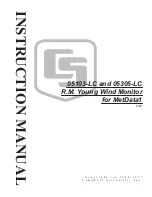
1
05103-LC AND 05305-LC R.M. YOUNG WIND MONITOR
FOR METDATA1
1. INTRODUCTION
This manual provides information for interfacing
the R.M. Young 05103 Wind Monitor and 05305
Wind Monitor AQ to the MetData1 system. The
05305 Wind Monitor AQ is a high performance
version of the 05103 Wind Monitor that is
designed specifically for air quality
measurements. R.M. Young's instruction
manual is also included, which contains sensor
specifications, operating principles, installation
and alignment guide, and calibration
information. Multiplier and offset values in the
Campbell Scientific notes are based on
calibration data obtained from the R.M. Young
Wind Monitor manual.
NOTE:
The black outer jacket of the cable
is Santoprene
®
rubber. This compound was
chosen for its resistance to temperature
extremes, moisture, and UV degradation.
However, this jacket will support
combustion in air. It is rated as slow
burning when tested according to U.L. 94
H.B. and will pass FMVSS302. Local fire
codes may preclude its use inside buildings.
2. MOUNTING REQUIREMENTS
The Wind Monitor mounts to a vertical piece of
1" IPS schedule 40 (1.32" O.D.) pipe. (See
Figure 2-1.) A band clamp at the base of the
sensor is tightened to secure the sensor to the
pipe.
Campbell Scientific supplies a 12" length of
unthreaded pipe for mounting the wind monitor
to Campbell Scientific's 019ALU Crossarm
Sensor Mount.
3. CONNECTION
The wind monitor cable is attached to the
MetData1 connector labeled #2.
4. DATALOGGER PROGRAMMING
NOTE:
Information in this section is not
necessary when programming the
MetData1 with the Short Cut Program
Builder software.
FIGURE 2-1. Wind Monitor Mounted to a
Vertical Pipe
4.1 WIND SPEED
MetData1 uses Instruction 3 (Pulse Count) to
measure wind speed.
The expression for wind speed (U) is:
U = MX + B
where
M = multiplier
X = number of pulses per second
B = offset
MetData1 Datalogger Program Instruction
01:
P3
Pulse Count
01:
1
Rep
02
1
Pulse Chan
03
21
Config Option
04:
*
Loc
05:
.2192** Mult
06:
0
Offset
*
Proper entry will vary dependent on input
location assignment.
** Use a multiplier of 0.098 for ms
-1
output.
The helicoid propeller has a calibration that
passes through zero; use an offset of zero (Gill,
1973; Baynton, 1976).
Summary of Contents for Young 05103-LC
Page 5: ...This is a blank page ...
























